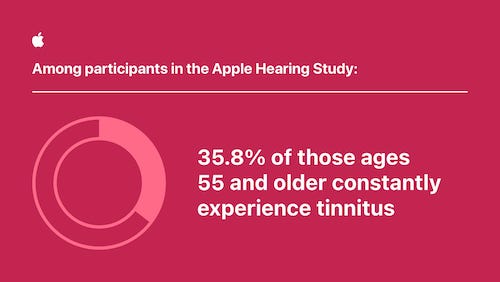Summary: New insights on tinnitus have emerged from the Apple Hearing Study, led by the University of Michigan, which involved over 160,000 participants.
Takeaways:
- The study found that 77.6% of participants have experienced tinnitus, with daily tinnitus prevalence increasing with age and more common in males.
- Tinnitus significantly affects quality of life, with common management methods including noise machines, nature sounds, and meditation, while cognitive and behavioral therapy is less frequently used.
- Most participants experience brief episodes, with older adults reporting more constant tinnitus. Tinnitus is often described as a pure tone or white noise, with detailed app-based sound tests helping to characterize these experiences.
New insights on tinnitus have been released from the Apple Hearing Study, which involves researchers from the University of Michigan reviewing survey questions about people’s experience with tinnitus.
About the Apple Hearing Study
University of Michigan researchers reviewed a cohort of more than 160,000 participants who answered survey questions and completed app-based assessments to characterize their experience of tinnitus. This research aims to improve understanding of tinnitus characteristics and inform future research on potential treatments.
“Roughly 15 percent of our participants experience tinnitus daily,” says Rick Neitzel, University of Michigan School of Public Health’s professor of environmental health sciences. “Tinnitus is something that can have a large impact on a person’s life. The trends that we’re learning through the Apple Hearing Study about people’s experience with tinnitus can help us better understand the groups most at risk, which can in turn help guide efforts to reduce the impacts associated with it. The Apple Hearing Study gives us an opportunity that was not possible before to improve our understanding of tinnitus across demographics, aiding current scientific knowledge that can ultimately improve management of tinnitus.”
The Impact of Tinnitus
Tinnitus, or the perception of sound that others do not hear, can happen to many people in one or both ears. With tinnitus, the sounds can take many forms but are most commonly described as a ringing sound and can be momentary or occur over longer durations. The symptoms and experience of tinnitus can vary significantly from person to person and can change for an individual.
Tinnitus can impact a person’s overall quality of life, for example, disrupting a person’s sleep, concentration, or ability to hear clearly.
A first step toward advancing understanding of tinnitus is to learn more about who experiences it, how the experience differs between people and within an individual over time, the potential causes, and the methods for managing tinnitus and their perceived effectiveness.

Tinnitus Prevalence
The study found that 77.6% of participants have experienced tinnitus in their life, with the prevalence of daily tinnitus increasing with age among many. Those ages 55 and up were three times more likely to hear tinnitus daily compared to those 18-34 years old. Additionally, 2.7% more male participants reported experiencing daily tinnitus compared to females. However, 4.8% more males stated they had never experienced tinnitus.
Management of Tinnitus
In the Apple Hearing Study, participants reported mainly trying three methods to ease their existing tinnitus: using noise machines (28%), listening to nature sounds (23.7%), and practicing meditation (12.2%). Less than 2.1% of participants chose cognitive and behavioral therapy to manage their tinnitus.

Characterizing Tinnitus
The majority of participants experience brief episodes of tinnitus, compared to 14.7% who reported constant tinnitus. The reported duration of tinnitus significantly increases with age among participants 55 and older: 35.8% of participants ages 55 and older constantly experience tinnitus. Male participants experience constant tinnitus nearly 6.8% more than females.
As for tinnitus levels, the majority found it to be faint, with 34.4% calling it noticeable compared to 8.8% who found it very loud or ultra loud. Approximately 10% of participants reported that their tinnitus has moderately or entirely interfered with their ability to hear clearly.
In addition to the survey questions, participants who experienced tinnitus also completed an app-based sound test to better characterize their experience of tinnitus, matching the type and quality of the sounds they experienced.
The majority of participants described their tinnitus as either a pure tone (78.5%) or white noise (17.4%). Among those who described a pure tone, 90.8% reported a pitch at 4 kilohertz or above, similar to the tones in a songbird’s call. Additionally, for those who described a pure tone, 83.5% identified their tinnitus as a single tone and 16.5% identified it as a teakettle tone — a high-pitched, whistling sound.
For participants who matched their tinnitus to a white noise, 57.7% identified it as a static tone, 21.7% compared it to a cricket tone, 11.2% said it was an electric tone, and 9.4% identified it as a pulse tone.
Further reading: Evaluating Apple AirPods Pro 2 Hearing Protection and Listening
Apple Research
The Apple Hearing Study is one of three landmark public health studies in the Research app on iPhone, which launched in 2019 and is ongoing.
Conducted in collaboration with the University of Michigan, the Apple Hearing Study advances the understanding of sound exposure and its impact on hearing health. Researchers have already collected about 400 million hours of calculated environmental sound levels supplemented with lifestyle surveys to analyze how sound exposure affects hearing, stress, and hearing-related aspects of health. Study data will also be shared with the World Health Organization as a contribution to its Make Listening Safe initiative.
All graphics courtesy of Apple



Plenty of brilliant interventions here… but I would urge researchers to step a little outside their comfort zone and explore this:
My tinnitus was present from age four to about 40. I visited a sacro-cranial osteopath – Dr Richard Holding – on another matter, and chanced to mention the whistling, which impacted my ability to hear him. He pressed very gently on my lower back for a minute, and the noise was gone! Being of a scientific turn of mind, I asked if he could bring it back. Yes, he said, a bit reluctantly of course. But he pressed, and back it came. OK? he asked, with a smile. One more press, and it was gone – for many many years.